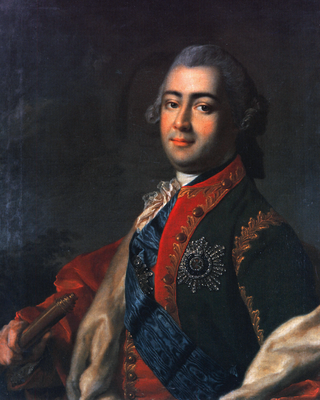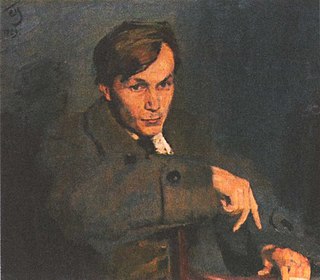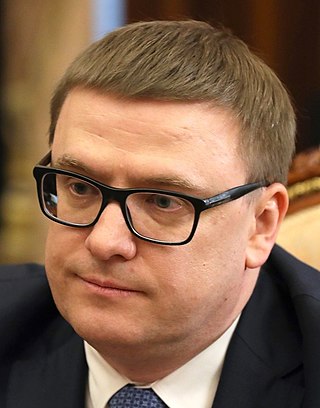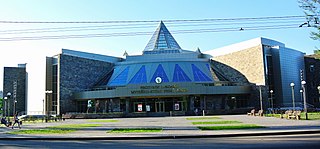
Count Alexei Grigorievich Razumovsky was a Ukrainian-born Russian Registered Cossack who rose to become the lover, and it was suggested he was the morganatic spouse, of the Empress Elizabeth Petrovna of Russia. A member of the House of Razumovsky, he survived Elizabeth. The matter of any children they may have had together is unresolved.

Princess Tarakanova was a pretender to the Russian throne. She styled herself, among other names, Knyazhna Yelizaveta Vladimirskaya, Fräulein Frank, and Madame Trémouille. Tarakanova is a later name, used only in entertainment, apparently on the basis of how she lived her last months and died. In her own time, she was not known by that name.

Vladimir Lukich Borovikovsky was a Russian artist of Ukrainian Cossack origin. He served at the court of Catherine the Great and dominated portraiture in Russia at the turn of the 19th century.

Konstantin Dmitriyevich Flavitsky was a Russian painter.

Eva Aurora Charlotta Karamzin was a Finnish philanthropist. Her better-known names are Princess Aurora Demidova and Aurora Karamzin, titles that were acquired after her first and second marriages, respectively.

Countess Varvara Nikolayevna Golovina, néePrincess Golitsyna was an artist and memoirist from Russian nobility, maid of honour of the Russian court, a close confidant of Empress Elizabeth, favorite Ivan Shuvalov's niece and Dame of Order of Saint Catherine (1816).

Aleksandr Alekseyevich Borisov was a Russian painter notable for his Arctic landscapes.

Girl with Peaches is an 1887 painting by the Russian painter Valentin Serov.

Anastasia Anatolyevna Tarakanova is a Russian retired figure skater. She is the 2017 JGP Austria and 2018 JGP Slovenia champion, and the 2017–18 JGP Final bronze medalist. She has won seven medals on the ISU Junior Grand Prix series.

Homeopathy Looks at the Horrors of Allopathy is an allegorical painting by Russian artist Alexander Beideman, painted in 1857. It is owned by the Tretyakov Gallery in Moscow, Russia. The picture measures 65.5 × 77.3 cm. and has the accession number 1795. In the 19th century, the painting was also known as Triumph of Homeopathy.

Princess Tarakanova is a 1910 Russian short film directed by Kai Hansen.

Ivan the Terrible and His Son Ivan on 16 November 1581 is a painting by Russian realist artist Ilya Repin made between 1883 and 1885. It depicts the grief-stricken Russian tsar Ivan the Terrible cradling his dying son, the Tsarevich Ivan Ivanovich, shortly after the elder Ivan had dealt a fatal blow to his son's head in a fit of anger. The painting portrays the anguish and remorse on the face of the elder Ivan and the shock and heartbreak of the dying Tsarevich, shedding a tear at the unexpected betrayal and shock of having been killed by his father's hands.
Vereshchagin's Turkestan Series is a collection of 13 paintings produced by Russian artist Vasily Vereshchagin in the 19th century. While initially purchased en masse by a Russian collector, the works have since been added to the collections of the Tretyakov Gallery in Moscow and the Russian Museum in Saint Petersburg.

Alexander Vladimirovich Grigoriev, was a Mari Soviet artist, public figure and academician. He is considered to be the first-renowned and the greatest Mari artist, who contributed to the development and formation of the fine arts in the Mari Territory.

Aleksey Leonidovich Teksler, is a Russian statesman and politician who is currently the 5th Governor of Chelyabinsk Oblast since 20 September 2019. He is also the secretary of the Chelyabinsk regional branch of the United Russia party since 2 October 2020.

In the Ploughed Field: Spring is an oil painting by Russian artist Alexey Venetsianov made in the first half of the 1820s. The painting depicts an elegantly dressed peasant mother leading two horses with a harrow while also keeping an eye on her child who is seated near the furrows. It has been in the Tretyakov Gallery in Moscow, Russia since 1893, and is regarded as one of Venetsianov's greatest works.

"Arrived on vacation" is an oil-on-canvas painting by Soviet artist Fyodor Reshetnikov. It was painted in 1948 and is an example of socialist themes in art. It is located in the Tretyakov Gallery in Moscow. In 1949, the artist was awarded the Stalin Prize of the second degree.

Piazza della Rotonda and the Pantheon is an oil-on-canvas cityscape painting by the Italian painter Bernardo Bellotto and his son Lorenzo, from 1769, based on an engraving by Piranesi. It and its pair View of the Forum in Rome are both now in the Pushkin Museum, in Moscow. It shows Piazza della Rotonda and the Pantheon, in Rome.

Marina Vitalyevna Vasilevskaya is a flight instructor and flight attendant for Belavia Airlines in Belarus. She is the first Belarusian woman to be launched into space.

The Khakassia National Museum is a museum located in Abakan, in the Minusinsk Hollow, Russia. It is located Ulitsa Pushkina, 28А Abakan, Respúblika Khakásiya, Russia, 655012.




















